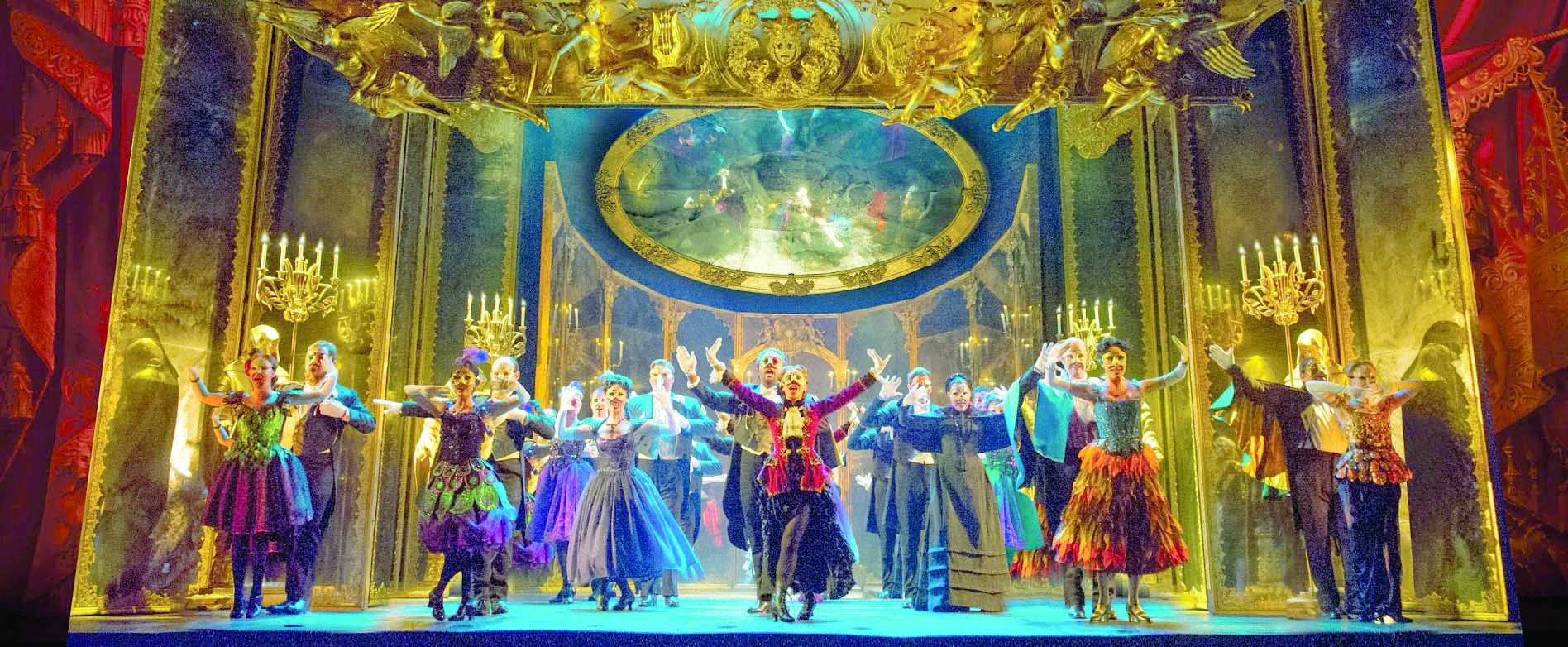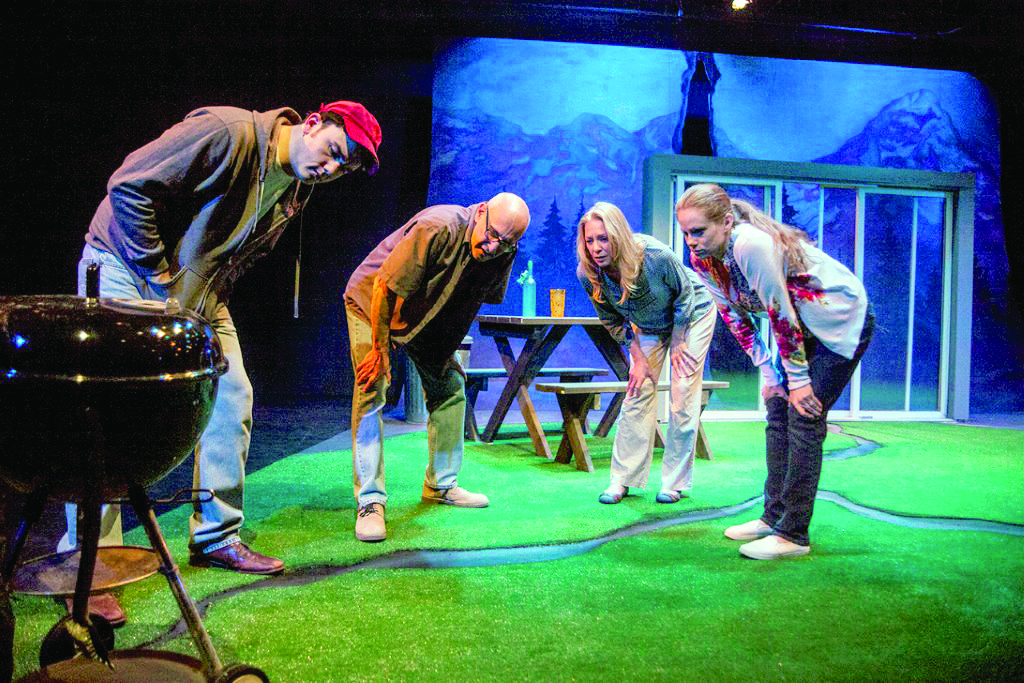The Shaw Festival
By Bob Abelman
Theater critic Bob Abelman has returned from Niagara-on-the-Lake in Ontario, Canada to report on this season’s offerings at the Shaw Festival. Here are his reviews-in-brief of five of the shows that have opened thus far and are running through October.
“Saint Joan”

The cast of “Saint Joan”. Photo | Emily Cooper
The 2017 production of Bernard Shaw’s “Saint Joan” marks two milestones and one millstone for in-coming artistic director Tim Carroll.
It is his Shaw Festival directorial debut, his first undertaking of a work by the Festival’s namesake, and his obligation to follow the tradition of former artistic directors Christopher Newton and Jackie Maxwell, who staged “Saint Joan” in 1981 and 2007, respectively.
The play examines the exploits of French military visionary Joan of Arc (Sara Topham in her Festival debut) – a 15th-century peasant girl proclaiming herself to be on a divine mission to save France from England.
Shaw made a conscious choice to focus on the private moments in her story rather than the big public events. We witness the prelude to but never see Joan’s siege of Orleans. Charles is crowned King in Rheims Cathedral, but we only overhear a conversation in a side chapel afterwards. We sit in on Joan’s trial but never observe her capture, imprisonment or execution. As a result, Shaw’s prose and poetry take center stage, which draw attention to the humanity behind the history and the ideas behind the idolatry.
Shaw also intended the play to be produced with simple staging, plain clothes and contemporary language to release the tale from its medieval moorings.
In response, scenic designer Judith Bowden and lighting designer Kevin Lamotte have created a dark, stark and wonderfully abstract performance space occupied by just a few hollow geometric objects that drop from the rafters. A narrow, vertical and translucent rectangle, for example, serves as Joan’s prison.
The action on stage seems untethered to any particular time or place, with only Claudio Vena’s sound design – which includes occasional medieval chanting from the cast members – hinting at the play’s historical context.
The performers are as comfortable with the rapid rhythms of Shaw-speak as classically trained actors would be with iambic pentameter at a Shakespeare festival. Everyone, particularly Topham as Joan and Festival mainstay Benedict Campbell as the Archbishop of Rheims, is interesting, engaging and adds the final ingredient to the production that turns “Saint Joan” into a show that should not be missed when visiting Niagara-on-the-Lake.
“Me and My Girl”

Kristi Frank as Sally Smith and Michael Therriault as Bill Snibson in “Me and My Girl”. Photo | David Cooper
“Bernard Shaw’s first impulse was to entertain,” notes Tim Carroll in his online Artistic Directors’ Message. “And that is the drive behind this whole season.” It is certainly the end-result of this season’s absolutely delightful showcase musical “Me and My Girl,” which was inspired by Shaw’s “Pygmalion.”
This frothy 1937 confection, with music by Noel Gay and book and lyrics by L. Arthur Rose and Douglas Furber, is set in England where a family of snooty aristocrats discovers that the legitimate heir to the title of Earl of Hareford is a smooth-talking cockney hustler named Bill Snibson (Michael Therriault). Before the estate can be passed to young Bill, he must be made into a proper gentleman and deemed worthy by the Duchess of Dene (Sharry Flett) and Sir John Tremayne (Ric Reid) of marrying Lady Jacqueline Carstone (Elodie Gillett).
In the end, Bill and his girl Sally (Kristi Frank) – like Eliza Doolittle before them – learn that becoming gentrified has its advantages and the upper-crust discover the simple joys of regular people.
As is the case with so many of the musical comedy romps of the 1930s, “Me and My Girl” is a thoroughly enjoyable compilation of fast-paced dialogue laced with rapier one-liners (Lady Jacquie: “I am not one to be simply tossed aside.” Bill: “No, you are to be thrown with great force.”), saccharine-sweet ballads, and huge madcap ensemble numbers that seem to surface out of nowhere and with little provocation.
And like so many of the musicals staged at the Festival, this show’s Broadway quality choreography (Parker Esse), sizable and stellar orchestra (directed by Paul Sportelli), eye candy design (set by Drew Facey and costumes by Sue LePage), and high-energy performances are nothing short of spectacular. “Me and My Girl” is certainly one of the highlights of the season’s offerings.
“1837: The Farmer’s Revolt”

The cast of “1837: The Farmers’ Revolt”. Photo | David Cooper
And then there’s “1837: The Farmer’s Revolt,” a dramatized history lesson where attendance is the due diligence one pays for shows like “Me and My Girl” and “Saint Joan.”
First performed by Toronto’s upstart Theatre Passe Muraille in 1973, the play tells the story of the Upper Canadian resistance against British imperialism and the unsuccessful 1837 rebellion that was fueled by American frontier democracy and led by a Toronto-based newspaperman William Lyon Mackenzie (Ric Reid).
It was originally told through simple folk art storytelling with an ensemble of six male and female actors playing dozens of characters regardless of gender. It is told here in a similar vein with eight actors, but is adapted by director Philip Akin to include color-blind casting and meet the high performance standards of the Festival.
After many seasons of watching the Shaw ensemble putting on accents to portray Dubliners, Brits and Americans, it is only right that a company of English-speaking Canadian actors play English-speaking Canadian characters in a patriotic drama by a Toronto-born – albeit Hebrew University of Jerusalem-educated – playwright, Rick Salutin.
Still, with a 2 hour and 15 minute run time, sitting through “1837: The Farmer’s Revolt” feels like homework.
“Dancing at Lughnasa”

The cast of “Dancing at Lughnasa”. Photo | David Cooper
Brian Friel’s deeply personal, Tony Award-winning memory play takes place in the summer of 1936 when the now-adult narrator, Michael (Patrick Galligan), was just 7 years old.
It revolves around five unforgettable women – his aunts Kate (Fiona Byrne), Rose (Diana Donnelly), Agnes (Claire Jullien) and Maggie (Tara Rosling) and his unwed mother Christina (Sarena Parmar) – who try but fail to eke out an existence in a small village in Ireland.
The elements that have slowly but efficiently eroded these women’s lives – their deep-rooted heartache and isolation, the hurtful gossip of the unseen community, and the advancing industrial revolution – are relayed through an undercurrent of longing and melancholy provided by the playwright’s novelistic and economic storytelling.
It is given physical form in Sue LePage’s simple scenic design that decorates the Royal George stage with the dull dark wood furnishings and serviceable artifacts of a modest home against a dramatic gray backdrop.
So thick is the sadness in this production, as directed by Krista Jackson, that it keeps the women’s intuitive and healing spirit of the dance from welling up as it should in the play’s most memorable and powerful scene. It also keeps the play at a bit of a distance despite the best efforts of the actors playing the Mundy sisters to be engaging and walk that fine line found in memory plays between what is actual and what is illusory.
“Wilde Tales”

Kelly Wong as Swallow, Marion Day as Happy Prince and Jonathan Tan as Worker in “Wilde Tales”. Photo | David Cooper
Oscar Wilde’s genius never blazed more brightly or in such short-form as his 1888 collection of children’s stories. Incoming associate artistic director Kate Hennig has cleverly adapted four of these stories – “The Happy Prince,” “The Nightingale and the Rose,” “The Remarkable Rocket” and “The Selfish Giant” – for the stage, featuring actors Marion Day, Emily Lukasik, PR Prudat, Sanjay Talwar, Jonathan Tan and Kelly Wong.
But this is not a piece of children’s theater, not with Wilde’s acerbic wit and satiric tonality and the infusion of Victorian sensibilities and symbolism that adults will find intriguing. If anything, this production’s introduction of Mike Petersen’s puppets, enchanting audience participation, and John Gzowski’s charming music to the power of eloquent speech bestowed upon a caring statue, selfless bird, egotistical firework and selfish giant are necessary to make these stories more accessible to children. And it does so brilliantly.
Jennifer Goodman’s set and costume designs, inspired by Victorian-era illustrations and toys, transform the Court House Theatre’s intimate performance space into an inviting garden. And at 55 minutes in length, “Wilde Tales” will easily hold the attention and stir the imagination of young and old alike.
Since its inception in 1962, the Shaw Festival has offered theater for two circles of audience – the hardcore theatergoers who come to Niagara-on-the-Lake for professional productions of provocative plays and the cultural tourists who come for the water sports, the wineries and the shopping but are drawn to the musicals or the more populist and familiar fare. This season, like the ones before it, offers world-class storytelling and exceptional production values that will please everyone. cv
Bob Abelman covers professional theater and cultural arts for the Cleveland Jewish News. Follow Bob at Facebook.com/BobAbelman3. 2017 Ohio AP Media Editor’s best columnist.
Originally published in the Cleveland Jewish News on June 26, 2017.
Lead image: Photo / Courtesy of the Shaw Festival











